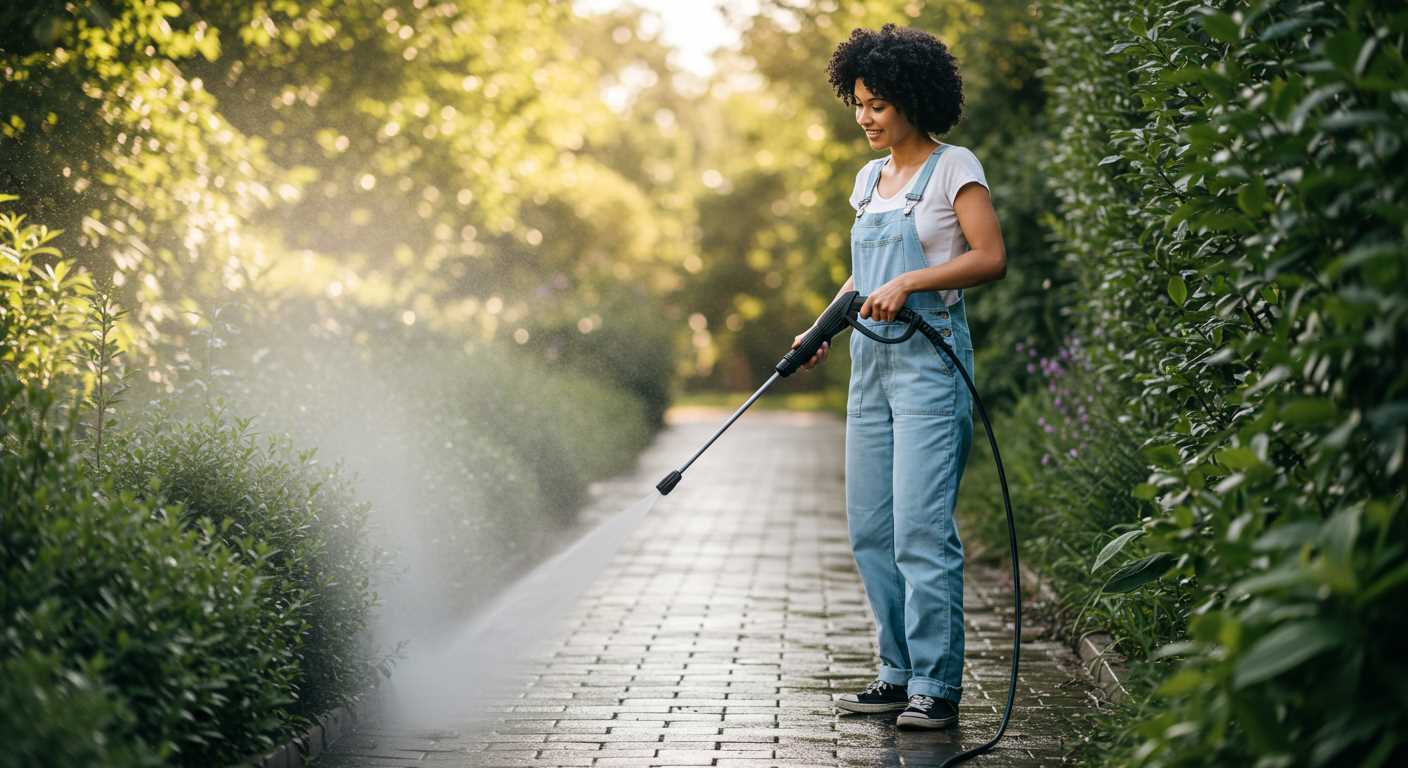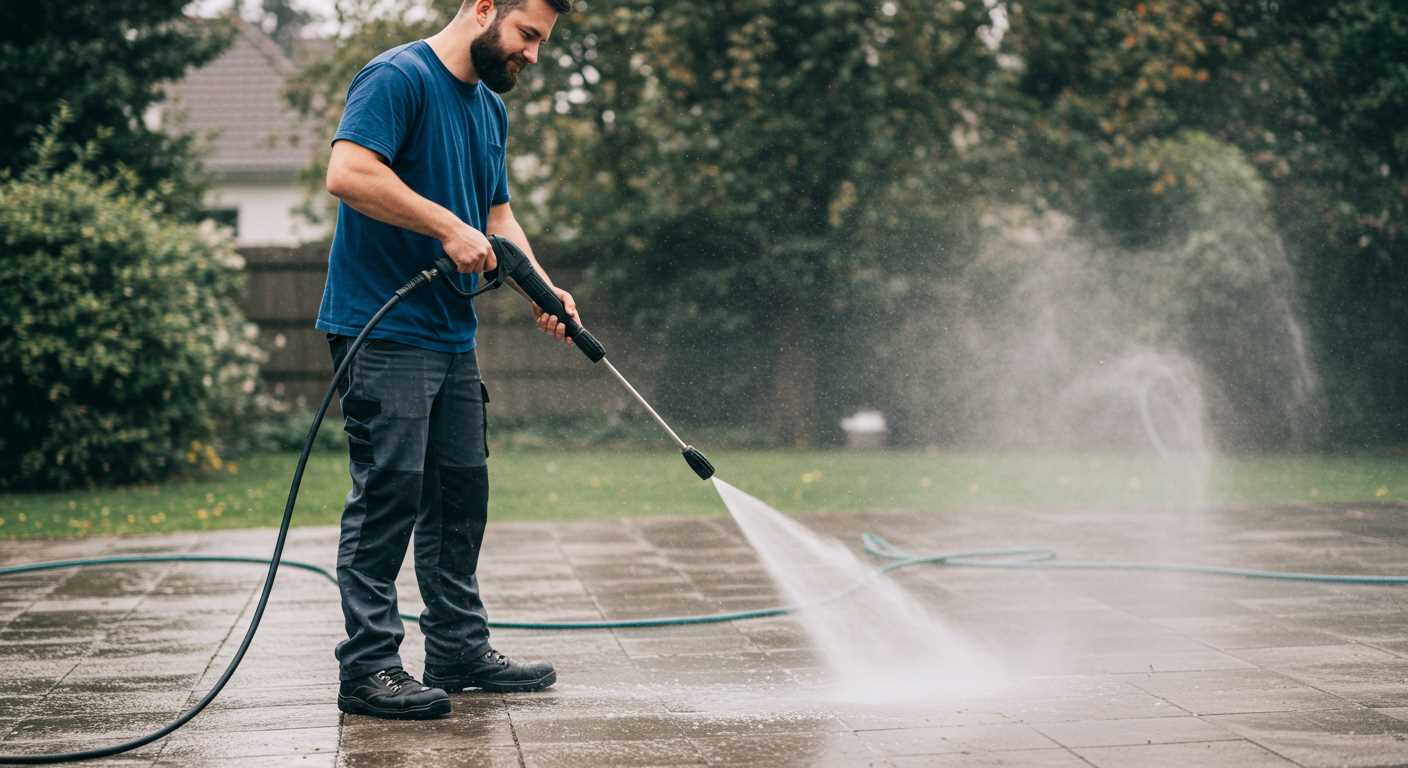



Begin by ensuring the correct nozzle is attached to your unit; for detergent application, a wide-angle nozzle usually works best. Additionally, confirm that the detergent tank is filled with the appropriate cleaning solution, as some designs incorporate a built-in reservoir specifically for this purpose.
Next, adjust the settings on your machine. Depending on the model, you may need to switch to “low-pressure mode” to facilitate the proper mixing of the cleaning agent and water. This mode allows the detergent to be sucked into the water stream effectively. Always refer to the manufacturer’s guide for specific adjustments regarding your equipment.
If your device utilizes a siphon tube, ensure it’s securely attached to the detergent container. This tube often protrudes from the machine’s base and should be submerged in the cleaning solution. Not all high-pressure cleaners use this method, so identification of your model’s operation is crucial. If you encounter resistance, inspect the tube for any bends or blockages.
Activate the machine and let it run for a few moments while pointed away from surfaces to clear any water initially present in the system. Gradually sweep the nozzle across the desired area, allowing the cleaning solution to coat the surface evenly for optimal results. Pay attention to any fluctuation in discharge; this can indicate an issue with suction or dilution that needs addressing.
Understanding the Soap Injection System in Your Pressure Washer
The soap injection system operates through a siphoning mechanism or a dedicated injector designed to mix cleaning agents with water. To ensure this system works efficiently, it’s crucial to use the correct type of detergent specified by your equipment manufacturer. Often, using a high-pressure cleaner detergent rather than a typical household cleaner is necessary.
To engage the soap injection, switch to the appropriate nozzle or lance that permits this function. Many units have a low-pressure nozzle for this purpose. Adjusting the nozzle correctly is essential; a wide spray pattern allows for better mixing of the detergent with the water stream.
Inspect the injector for clogs or blockages. Regular maintenance, including cleaning filters and hoses, ensures optimal performance. If there’s a lack of flow, check for any kinks in the hoses or potential leaks that may disrupt the flow of the solution.
For optimal results, applying the mixture in a consistent, sweeping motion allows for even coverage of surfaces. It’s beneficial to let the solution dwell for a specified time before rinsing, as this increases its effectiveness against dirt and grime.
The length of the hose and the distance between the detergent tank and the injector can affect how well the solution is mixed. A shorter length generally enhances performance. Always ensure that the reservoir is filled with the appropriate mixture ratio of detergent to water, as specified in the user manual.
Regularly testing the system’s functionality can prevent issues. If there are persistent problems, consulting the manufacturer’s troubleshooting guide or contacting customer support may be necessary. Following these guidelines helps maximise the capabilities of the soap injection system, ensuring a thorough clean.
Choosing the Right Detergent for Your Cleaning Equipment
Select a detergent specifically formulated for use with pressure cleaning machines. Look for products that clearly state compatibility with your equipment to avoid any damaging reactions within the system.
Concentrated formulas are preferable. They offer greater cleaning power while requiring less product overall. This can lead to significant cost savings over time, as well as reduced environmental impact.
Type of Surface

Match the detergent type to the surface being cleaned. For example, heavy-duty cleaners work well on concrete and driveways, whereas gentle solutions are ideal for delicate finishes like wood or painted surfaces. Consider bio-based options that provide effective cleaning without harsh chemicals.
Environmental Considerations
Be mindful of environmental impacts. Choose eco-friendly detergents that break down easily and pose minimal risk to surrounding flora and fauna. Check labels for biodegradable claims and certifications from relevant environmental organisations.
Setting up the unit for optimal detergent application

Attach the chemical nozzle to the lance, ensuring a secure fit. This specific nozzle, often wider than standard ones, allows for a gentle application of cleaning agents. Double-check that the nozzle is compatible with your model to prevent clogs or malfunctions.
Next, confirm the presence of a siphon tube in the cleaning solution container. This tube should be connected properly, reaching into the soap reservoir. If the tube is damaged or incorrectly placed, it won’t be able to draw in the liquid needed for the task.
Water Pressure Adjustment
Lower the pressure to a suitable level by adjusting the pressure control knob. Excessive force can inhibit the functionality of the chemical system, potentially causing damage or preventing the cleaner from mixing correctly. Start with a lower setting and gradually increase as needed.
Pre-Usage Check

Before commencing, ensure the hoses are free of kinks and the filters are clean. Blockages can prevent proper flow, leading to ineffective application. Fill the chemical reservoir adequately, allowing the mix to flow unimpeded.
| Step | Action |
|---|---|
| 1 | Attach chemical nozzle to the lance |
| 2 | Check and connect siphon tube |
| 3 | Adjust pressure settings |
| 4 | Inspect hoses and filters |
| 5 | Fill detergent reservoir |
Following these guidelines ensures the device operates efficiently, delivering a thorough cleaning experience. Regular maintenance will also prolong its lifespan and maintain performance standards.
Adjusting the Nozzle for Optimal Liquid Flow
Set the nozzle to a lower pressure setting to enhance liquid flow during cleaning tasks. A wider spray pattern can facilitate the mixing of the detergent for a more effective application.
- Switch to a soap nozzle, usually marked by a different colour, to ensure proper injection.
- Turn the nozzle to adjust the spray angle, aiming for a broader pattern which mixes the cleaner more uniformly.
- Observe the distance from the surface; keeping it too far can diminish the effectiveness of the mixture, while being too close might cause excessive splatter and reduce coverage.
Regularly check for clogs in the nozzle, as even minor blockages can affect liquid delivery. A needle or thin wire can assist in clearing these obstructions.
- Examine the nozzle settings frequently after extended use to maintain ideal performance.
- Consider using quick-connect nozzles for versatility, allowing easy switching between applications.
Finally, matching the nozzle size to the model specifications ensures optimal performance, preventing any unintended pressure issues.
Troubleshooting common soap dispensing issues
Verify that the cleaning solution is compatible with your device. Some formulas can clog the injection system if not designed for high-pressure applications. If you notice thick residues or clogs, consider switching to a different product.
Check for blockages in the injection tube and filters. Detach the hose and inspect for any kinks, bends, or debris that could obstruct fluid flow. Cleaning or replacing filters can often resolve flow issues significantly.
Inspecting the nozzle and connection
The nozzle has a significant influence on fluid movement. A worn or damaged nozzle can decrease pressure and affect the flow of cleaning fluid. Ensure the nozzle is clean and in good condition, replacing it as needed for optimal results.
Adjusting settings and pressure levels
Examine the pressure and setting adjustments on the unit. Too high a pressure setting may prevent adequate drawing of the solution. Lowering the pressure can often enhance the suction from the reservoir, allowing for a better mixture of water and cleaner.
Lastly, if these measures do not resolve the issue, consult your manual for specific troubleshooting steps or consider reaching out to customer support for further assistance.
Cleaning and Maintaining the Soap Injection System
Regular maintenance of the detergent injection mechanism is vital for optimal operation. Begin by rinsing the system thoroughly with clean water after each use to flush out any residual cleaning agents. This minimizes the risk of clogs and build-up.
Check and Replace Filters
Inspect the filter associated with the soap intake. If it appears dirty or damaged, replace it to ensure proper flow and prevent contamination of the cleaning solution. I recommend doing this maintenance check periodically, especially if you frequently use chemical solutions.
Inspect Hoses and Connections
Examine the hoses and connections for signs of wear or leakage. Any worn components should be replaced promptly. Use silicone grease on threads to promote a tight seal and aid in easy disassembly during future maintenance.
After cleaning, I suggest operating the device briefly without detergent. This helps to clear any lingering solution within the system. Keeping the injection system free from contaminants will ensure a longer lifespan and reliable performance.
Additionally, storing your equipment in a cool, dry place away from direct sunlight will help maintain its integrity and functionality. Following these steps will ensure that your detergent injection system operates smoothly when needed.
Safety Precautions When Using Cleaning Solutions with High-Pressure Equipment
Always wear protective gear, including gloves, goggles, and a mask. This prevents skin contact, eye injury, and inhalation of harmful chemicals that may be present in the cleaning agents.
Conduct a risk assessment of the area before starting. Remove any obstacles, cover sensitive plants and surfaces, and ensure no individuals or pets are in proximity. A clear workspace significantly reduces the chance of accidents.
Store cleaning agents in their original containers, tightly sealed and away from heat sources. Keep them out of reach of children and animals to avoid accidental ingestion or spills.
Prior to use, thoroughly read the labels of all cleaning solutions. Understanding the warnings and proper handling instructions helps to mitigate risks associated with chemical exposure.
Mix solutions in well-ventilated areas to avoid inhaling fumes. Poor air circulation can amplify health hazards posed by certain chemicals.
Perform a test on an inconspicuous area if uncertain about the product’s compatibility with surfaces. This avoids potential damage and ensures the effectiveness of the cleaner.
Never switch products without flushing the system first. Residual chemicals can react adversely, leading to dangerous situations.
After completing the task, clean all equipment properly. Rinse any components that have come into contact with cleaning agents to prevent build-up and ensure longevity.
In case of any accidents or spills, be prepared with an emergency kit that includes neutralising agents, absorbents, and first aid supplies. Swift action is key to preventing further harm.
FAQ:
What steps should I follow to get soap to dispense from my pressure washer?
To get soap to dispense from your pressure washer, begin by checking that your machine has a detergent tank or a soap injection system. If it does, fill the tank with the appropriate soap mixture, avoiding any thick or caustic substances. Next, make sure to switch the nozzle on your pressure washer to a low-pressure setting, usually indicated by a soap or low-pressure nozzle. Once everything is set up, pull the trigger on the gun and observe if the soap begins to flow. If it is not dispensing, check for clogs in the nozzle or the soap inlet line. You may also need to adjust the pressure to ensure that sufficient suction is created to pull the soap into the system. Regular maintenance can prevent blockages and ensure smooth operation.
Why is my pressure washer not dispensing soap, and how can I fix this issue?
If your pressure washer is not dispensing soap, there are several potential reasons and corresponding solutions to consider. First, verify that the detergent tank is filled with the correct soap and that the liquid is not too thick. Clogged hoses or nozzles can prevent soap from flowing, so inspect these parts for any blockages. Another common issue is the pressure setting; ensure you’re using a low-pressure nozzle, as high pressure can inhibit soap dispensation. Check the soap injector system, if your model has one, for any damage or obstructions. Additionally, ensure that the soap is being mixed correctly; sometimes, the ratio of soap to water might be incorrect, affecting the flow. If all else fails, consulting the user manual or reaching out to customer support may provide additional troubleshooting steps specific to your model.









